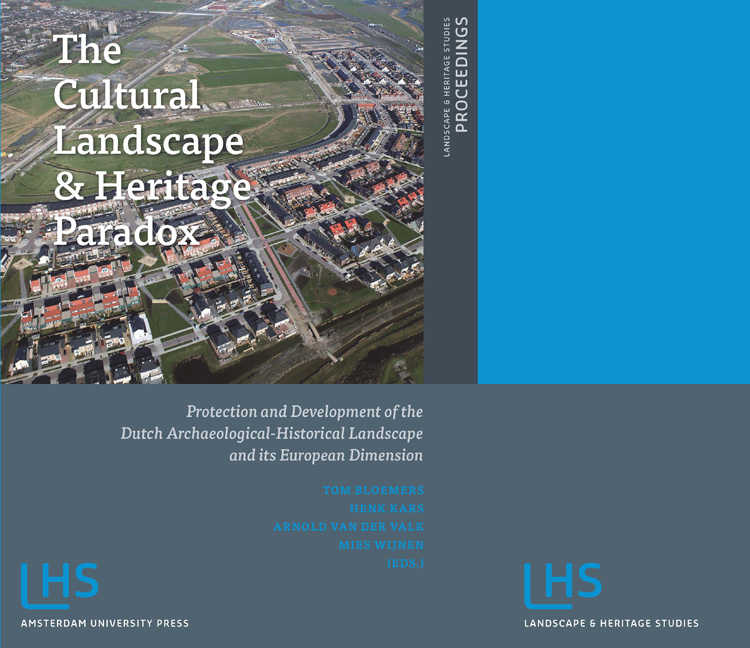 The Cultural Landscape and Heritage Paradox
The Cultural Landscape and Heritage Paradox Book contents
- Frontmatter
- Contents
- Preface
- I INTRODUCTION
- II INSIGHTS AND PROSPECTS OF ARCHAEOLOGICAL-HISTORICAL LANDSCAPE STUDIES
- III LINKING KNOWLEDGE AND ACTION
- IV IMAGINATION - FACTS AND CONSTRUCTIONS
- V SHARING KNOWLEDGE - STORIES, MAPS AND DESIGN
- VI SYNTHESIS AND CONCLUSIONS
- VII MANAGEMENT OF KNOWLEDGE
- VIII AGENDA FOR THE FUTURE
- IX SUMMARY
- X APPENDIX
- Subject Index
- Index of Places and Regions
9 - ‘Green’ and ‘blue’ Developments. Prospects for Research and Conservation of Early Prehistoric Hunter-Gatherer Landscapes
Published online by Cambridge University Press: 21 January 2021
- Frontmatter
- Contents
- Preface
- I INTRODUCTION
- II INSIGHTS AND PROSPECTS OF ARCHAEOLOGICAL-HISTORICAL LANDSCAPE STUDIES
- III LINKING KNOWLEDGE AND ACTION
- IV IMAGINATION - FACTS AND CONSTRUCTIONS
- V SHARING KNOWLEDGE - STORIES, MAPS AND DESIGN
- VI SYNTHESIS AND CONCLUSIONS
- VII MANAGEMENT OF KNOWLEDGE
- VIII AGENDA FOR THE FUTURE
- IX SUMMARY
- X APPENDIX
- Subject Index
- Index of Places and Regions
Summary
ABSTRACT
This article discusses the possibilities of future research of early prehistoric remains within large-scale nature management and water management developments. It is especially in these projects within the Archaeological Heritage Management that a landscape approach can be used. The landscape approach is seen as a crucial way of researching remains of communities from early prehistory. These large-scale development projects take place in landscape zones where archaeological remains might be found which hint at the social and ritual use of the landscape in early prehistory. This new information has to be integrated in existing (mainly economic) models of early prehistoric land use. This information can eventually be used to communicate the way of life of these early prehistoric communities and their large-scale land use to a wider public.
KEY WORDS
Early prehistory; nature development, water management; multidisciplinary research; northern Netherlands
INTRODUCTION
About 50% of the time span of our cultural history consists of activities and land use by early prehistoric hunter-gatherers. Unfortunately, the archaeological remains of these activities hardly seem spectacular at first sight. In this article the focus will be on surface scatters roughly dating to the Late Palaeolithic and Mesolithic (c. 12,300-4,900 cal BC). In particular, on dry Pleistocene coversands in the Netherlands these remains consist of nothing more than several flint scatters or pits filled with charcoal which presumably functioned in terms of food preparation. Based on these remains a picture may emerge of early prehistoric people spending their time digging pits, burning fire and knapping flints. It is believed that this is a meagre and uniform picture which does not resemble reality.
THE NATURE OF EARLY PREHISTORIC SOCIETIES
Analysis of the enormous quantitative number of, at first sight, uniform Stone Age sites presents a picture of societies with a huge spatial, diachronic and synchronic variation in for example migration patterns, resource procurement strategies and probably site types. One of the most important characteristics of early prehistoric hunter-gatherer societies is their large-scale land use and certain degree of mobility (Kelly 1995). From ethnography we know that sizes of home ranges can vary to an enormous degree, for example the Nunamiut Inuit have a home range area of 5400 km2 (Binford 1983; Jochim 2003). There were probably different degrees of mobility so this did not mean that there was no special attachment to particular places like burial grounds or central places.
- Type
- Chapter
- Information
- The Cultural Landscape and Heritage ParadoxProtection and Development of the Dutch Archaeological-Historical Landscape and its European Dimension, pp. 329 - 338Publisher: Amsterdam University PressPrint publication year: 2010
- 1
- Cited by


